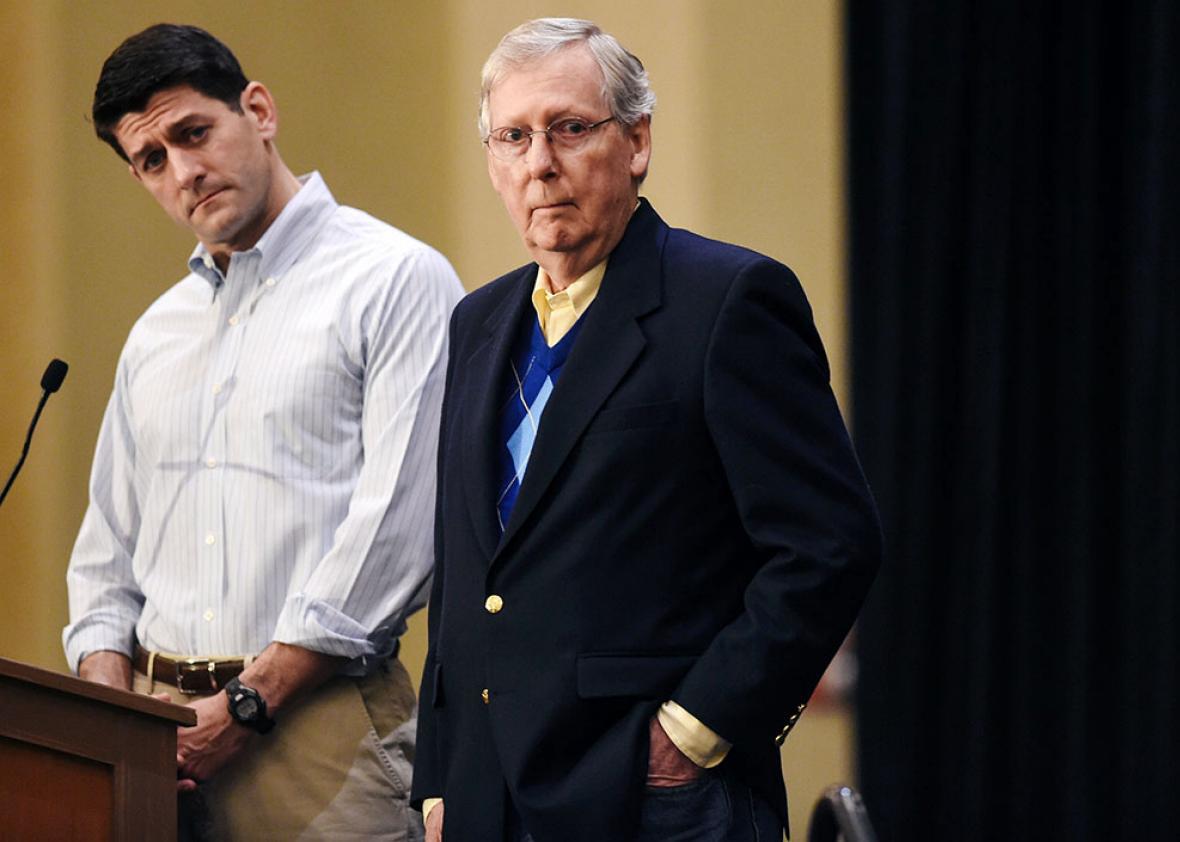PHILADELPHIA—Paul Ryan almost made it until the end of a press conference without facing a question about whether he could maintain, under a Trump administration, the budget-cutting principles he espouses. But not quite. The last question he faced Thursday morning, at an appearance with Senate Majority Leader Mitch McConnell near the joint GOP retreat in downtown Philadelphia, asked whether he would commit to not spiking the deficit since fiscal responsibility doesn’t always carry the day under unified Republican governments.
“You know us well, you’ve been covering budgets for a long time,” Ryan told the reporter who asked the question. “We are fiscal conservatives. What that means is we believe government should not live beyond its means. We believe that hardworking taxpayers deserve a break in this country. And that means Washington takes less money from them, and we also spend less here.” As Ryan walked out, he passed the reporter who asked the question, smiled, and again said, “You know us.” Right? Right.
Let’s put aside, temporarily, what those who have covered Republican spending under unified governments “know” about it—or just compress it into five syllables: “Medicare Part D.” And for the sake of argument, let’s hypothesize that Republican congressional leaders are more serious about maintaining fiscal responsibility in this latest experiment with unified rule. The problem, still, would be that the head of this unified government, even more so than the last head of a unified Republican government, does not appear to care whatsoever about fiscal responsibility. And he wants to spend.
He wants to spend for “the wall,” at least until that theoretical future point at which Mexico reimburses the cost. It will be Congress’s job this spring, as Ryan put it Thursday morning, to facilitate “the deployment of the fence” that’s already authorized for construction. Congress just has to appropriate the money.
Some answers about that process have come out of this retreat. The plan is to fund the wall through a supplemental appropriations bill in the spring, and Ryan said it would cost about $12 billion to $15 billion. (That estimate may increase if the supplemental is larded up with other treats to buy members’ votes, a not-uncommon occurrence. Especially if it’s not must-pass legislation.)
Are they going to pay for that?
It took three attempts from reporters to ask Ryan and McConnell about whether they’d offset the cost of the fencing before they stopped pretending that they didn’t hear the question.
“We’re going to wait and see on the administration what their supplemental looks like,” Ryan said. “I’m not going to get ahead on a policy and a bill that has not been written yet. But the point is, we are going to finance the Secure Fence Act.”
Ryan won’t say much. But that they’re looking to get this money in a supplemental instead of the usual government funding process process is a telling sign.
If they’d chosen to try to get the money through a must-pass government funding bill, it would be harder to get that $12 billion to $15 billion without making hard cuts elsewhere. When Politico reported earlier this month that Republicans were considering inserting the fence money into the April continuing resolution, House Minority Leader Nancy Pelosi anticipated they’d have trouble drumming it up. “That’s a lot of money to put on a CR for a very stale authorization,” she said.
“We’re operating under caps, defense and domestic, so what is this coming out of?” she said. “Is this coming out of domestic discretionary, is this coming out of education, is it coming out of everything we do on the domestic side? That’s a lot of money, billions and billions of dollars. It will be interesting to see how they proceed on that.”
They’ve proceeded by changing the plan. If the money is appropriated through a supplemental requested by the White House, they can designate the border situation an “emergency” and effectively skirt the budget caps that are in place.
“Given [Trump]’s rants about undocumented immigrants, he could easily conclude that it is an emergency,” a senior House Democratic aide says. “Of course, [Republicans] have insisted that some emergencies be offset or refused to acknowledge a situation as an emergency (i.e., Flint). Hypocrisy [is] likely to be a key component of the ‘wall.’ ”
Late Thursday afternoon, Sean Spicer, Trump’s press secretary, said that he hoped payment for the wall would come through … some sort of treatment of imports from Mexico. His talking points conflated the sexy, punitive language of tariffs with border adjustment, the latter of which congressional Republicans may include in a comprehensive tax reform package. Either way, that package would pass Congress later this year, if indeed it can pass Congress. Money for the wall—even if it’s just a starter sum—is expected to come this spring. The two are separate.
I try not to get really worked up about politicians’ hypocrisy. Voters don’t much care, after all; they like getting what they want regardless of what a politician has said in the past. The voters who are going to want the wall most, and don’t particularly care how it’s paid for, are likely to be constituents of the far-right members who rarely supported a dime of spending requested by the Democratic president—offset or not.
If Republicans appropriate $15 billion for a lengthy double-sided fence and use “Mexico’s going to pay for it later” as their excuse for not covering the cost, they’ll make their base happy. They’ll get away with it. And we will know who they are.
